View Ballybough, D3 – Part I in a larger map
Whitworth Place just over the canal from Dorset Street is one of the oldest streets in this part of Dublin pre-dating 1837 and the street is still quite traditional though it does appear that several of the houses are now multi-unit dwellings. One interesting property on the street is number 3a which appears to have been an archway leading to a back street behind the terrace and has now been converted into a small house between numbers 3 & 4. Beyond Whitworth Place in 1837 was all agricultural land and open rolling fields, hard to believe when you see it today.
 The Widows Retreat was located on Drumcondra Road beside Fitzroy Avenue and was built in 1815. The original institution was built by the Latouche family and contained 12 rooms, each containing 2 beds. Widows were each given 2s. 6d. per week to live on and dined in a common area downstairs. This institution was still in operation in 1907 but today it appears that the property is again converted into a multi-unit dwelling. By 1907 the relatively regimented development of rows of Georgian terraced housing were built and thankfully the area looks predominantly the same today.
The Widows Retreat was located on Drumcondra Road beside Fitzroy Avenue and was built in 1815. The original institution was built by the Latouche family and contained 12 rooms, each containing 2 beds. Widows were each given 2s. 6d. per week to live on and dined in a common area downstairs. This institution was still in operation in 1907 but today it appears that the property is again converted into a multi-unit dwelling. By 1907 the relatively regimented development of rows of Georgian terraced housing were built and thankfully the area looks predominantly the same today.
St. Patricks Terrace
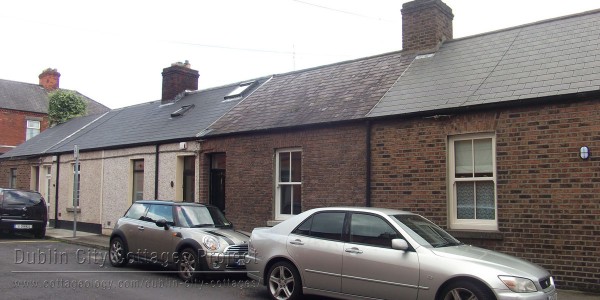
A tiny terrace of just five single story cottages. Constructed of the multi-toned brown brick these little cottages have rectangular fanlight doorways and a single window. On one end of the terrace the cottages have an original appearence, featuring original brickwork and sash windows though the next two have been pebble dashed and have had their windows replaced with non traditional PVC. Number 1 has a recessed doorway with the meter box just inside, I have seen this feature in some cottages in the Ringsend/Irishtown areas but in this case I assume that this was added subsequently by owners for shelter.
St. Georges Avenue
Just before the entrance to Elizabeth street at St. Georges Avenue is a really quite traditional looking older 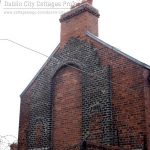 shop front. Unfortunately it is no longer in use but you could imagine it as a popular local older grocers store. One feature of the area is the unusual brick shapes on the gable wall of some buildings. When the rail bridges were being built some older properties had to be knocked to make space. The brick outlines of the fireplaces and chimney breast on the gable wall of the adjoining building form an intriguing pattern. This is most obvious on number 11 St. Georges Avenue as the brickwork is a dark brown set against the redbrick.
shop front. Unfortunately it is no longer in use but you could imagine it as a popular local older grocers store. One feature of the area is the unusual brick shapes on the gable wall of some buildings. When the rail bridges were being built some older properties had to be knocked to make space. The brick outlines of the fireplaces and chimney breast on the gable wall of the adjoining building form an intriguing pattern. This is most obvious on number 11 St. Georges Avenue as the brickwork is a dark brown set against the redbrick.
Elizabeth Street
Access to Elizabeth Street from St. Georges Avenue is quite tight due to its proximity to the rail bridge. The cobbles peeping through the tarmac at intervals hint back to the streets older aesthetic. The cottages are two story with the single window on the first floor and a typical square fanlight over the door. The roofs are flush with the fascia and constructed of slate with typical brickwork detailing over the doors and windows. The street is quite narrow and faces directly on to the train lines.
Further down the street the style of the cottages change with orange toned brick detailing over the windows connecting across the buildings and decorating under the eaves. The brickwork itself also changes to the multi-toned beige through brown brick variety and the upstairs window is located directly above the downstairs window as opposed to central. In some of the houses you can still see the an original orange brick detail at the lower plinth also – even in mass low-end developments like these, the thought that went into the details really has lasted the test of time. Several of the houses on the street have been re-faced and the difference is starkly noticeable, the bricks are uniform and lack the character of their older counterparts and the craftsmanship in the detail work is simply absent.
Mable Street
This style of house continues on to Mable Street though unfortunately much of the original character is lost on most of the houses on this street as many of the beautiful brick exteriors have either been smooth rendered over or again the fronts have been re-faced with modern uniform brick (see above picture extreme left and right). The numbering system on this street is a little strange as number 10 seems to be missing but perhaps that has something to do with the train line again – it may have been knocked to make way for progress or never built at all.
Robert Street
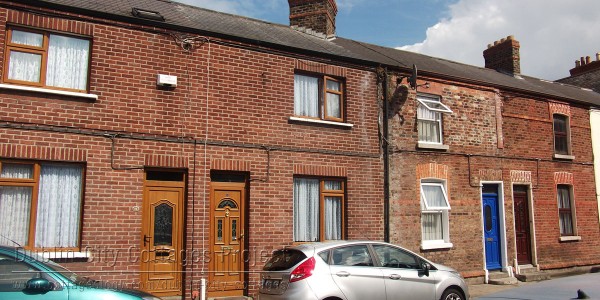
Robert street consists of just 8 cottages of the same style as those towards the end of Elizabeth Street. The houses front onto the train lines with ad hoc commercial buildings protruding from the rebricked arches and Croke Park looming in the background. A notable feature here again is that all of the cottages are odd numbered, a fact that had escaped the attention of the residents I was speaking to from Robert Place. Perhaps these cottages were built around the same time as the railway and were supposed to have counterparts across the street.
Two of the cottages have been refaced with modern redbrick and have also had their windows enlarged. While the re-development might allow more light it is a sincere pity to see how they interrupt the natural flow of the street with art-less brickwork that is a careless nod to the craftsmanship of the original cottages. I don’t pretend to know the reason for this type of remedial work, perhaps the facades had become dangerous but the quality of the re-instatement is exceptionally poor and uncharacteristic of the area.
Robert Place
Robert place is a tiny section at the end of Robert Street containing three original cottages that have all been either rendered over or pebble dashed and one modern build squeezed between Robert Street and the old school on Jones Road. This used to be one of the main access routes to the school that was nestled behind the methodist church on Jones Road.
Jones Road
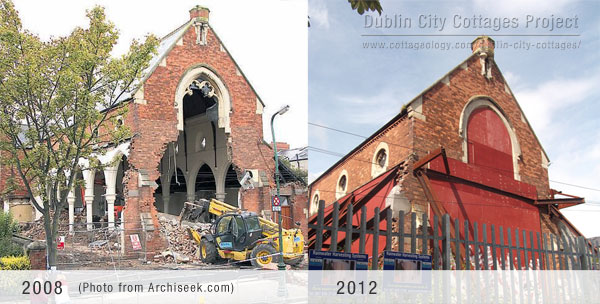
Following the lane down and around from Robert Place brings you out onto the famous Jones Road – one of the age old ‘slighe GAA’ routes where every summer and autumn hordes of hopeful GAA fans flow festooned in county colours in the hopes of becoming All Ireland Champions.
One of the most prominent features on this street (other than the aforementioned Croke Park) is the old Methodist Church. At over 130 years old, an unnamed ‘developer’ caused outrage in 2008 when they carelessly demolished the front of the building after having been served with an enforcement order to stop development. At 6am the following morning teleporter was driven straight through the front of the building and the operator fled the scene, you couldn’t write this stuff! Four years on and the building remains in a state of disarray with steel scaffolds holding it up and boards sheathing the gaping hole left behind by their handiwork. Frustrating.
Russell Avenue

At the lower end of Russell Avenue – close to Jones’s Road there is a terrace of 14 small single story cottages. The doorways have aspirations to the larger Georgian houses surrounding them with originally ornate doorcase surrounds. The fanlight is rectangular with a slight curved upper arch and the eaves are flush with the roof and have the stepped brick feature. This is a charming little terrace and the slightly more ornate features that are seen here continue down into Ballybough.
On the oposite side of the avenue there are a further four of these original style cottages though one has been altered so that the front window is much wider and the brickwork has been rendered over, again the alterations detract from the original character of the building though not as severely as the alterations on Robert Street.
Holy Cross Avenue
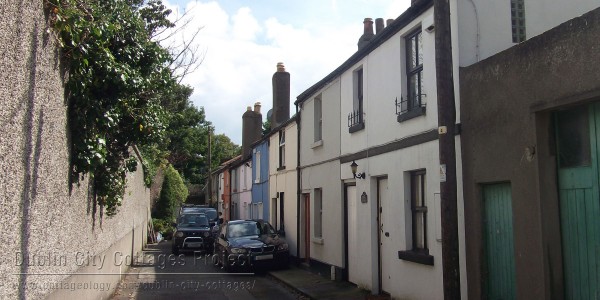
This is slightly outside of my survey area but it is so unexpected and charming that it could not be ignored. At the end of the beautifully tree lined Holy Cross Avenue you veer onto a little terrace of cosy cottages gazing at the walls of the old Jones Estate. These were the cottages of the stable workers of the estate, at the end of the laneway were the old stables though they are long gone.
There appear to have been seven original cottages with an additional two houses having been built at the edge of the lane.
Next Week – Ballybough Part II – Jones’s Road to Ballybough Road
Relevant Links:
Dublin City Cottages Project Outline
Dublin 1:
– Dublin 1, Part I – History and Seville Place Area
– Dublin 1, Part II – North Strand Road Area
– Dublin 1, Part III– Charles St. Great, Summerhill & North Circular Road Areas
Dublin 3:
– Dublin 3 – Ballybough – Introduction and History
– Dublin 3 – Ballybough Part I – Drumcondra Road to Jones Road


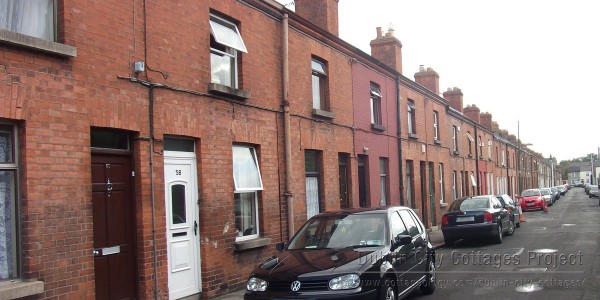

Very interesting site! I grew up in this area (Fitzroy Avenue) so I know it well!
Hiya Ewan! Thanks for the comment – Fitzroy Avenue is gorgeous, you’ll have to tell me what it was like growing up there sometime!
O
Hi, I love this site! I stumbled upon it while researching material for a novel. Have you any idea when the houses on Jones Road and/or Mable St were built? Thanks
Hi Evelyn, sorry I missed this comment – it got lost among all the spam comments! I don’t know when they were built – it was there in the 1907 maps but was only a field in the 1837 – it might be possible to track it down by going through all the Thoms Directories but would take a lot of time. They are located in both the National Library and Pierse Street Library in the Local Collections. I hope this helps with your book,
Orla
Hi Orla,
Really hoping that 10 Mabel street wasn’t knocked down or worse still never built at all! I live in it!
Brilliant – I just couldn’t find the slippery devil – where was it hiding :-D!
Hello Orla, I am trying to trace my Mooney ancestors in Dublin. Not in your area,I suppose, but I just wondered if you knew of any cottages at the gate of Glasnevin Cemetery. My g grandfather John Mooney was born in Dublin c1824. He was a stone mason and range setter. Don’t know his parents’ names, (possibly Joseph and Mary) but He married in Newtownards, County Down, having come up to install fireplaces. A family gravestone here in Movilla Cemetery may have been made by him. An 1845 directory has a James? Mooney monumental mason, who seemed to have lived… Read more »
Hi Margaret, gosh – I wish I had written a book but unless I am rocking a serious case of amnesia – you may be looking for another person for this comment :-). Tracing ancestry is outside of my very limited superpowers but there are a lot of amazing ancestry experts about who should be able to help you. I’ll post the comment and you never know – a reader might have information that they could pass on to you. Best of luck with your search :-).
Hi Orla,
just came across your very interesting site while researching my family history. A number of my maternal ancestors – Rooney, Rigney and Whelan families lived in Robert Street, Elizabeth Street and Robert Place at some time or other from around 1893 and as far as I know one, Mary Whelan, was still living in 9 Robert Street until her death in 1975.
Many of the males in these families worked on the railway.
Thank you for the background on these streets.
John Brennan